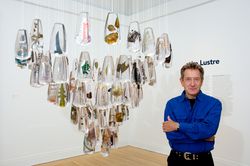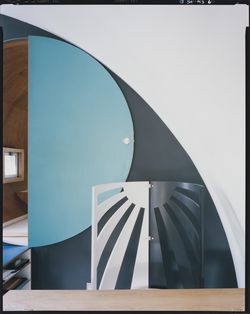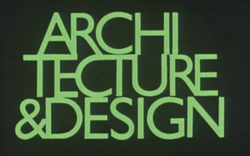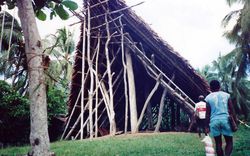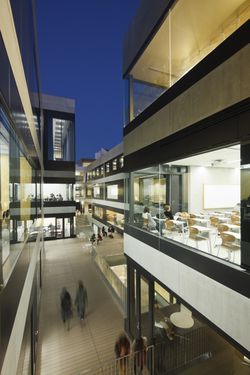Gilles Clément
French horticultural engineer and landscape architect Gilles Clément presents his projects and theories in the context of the CCA exhibition Environment: Approaches for Tomorrow (2006). The exhibition proposes a shift in perspective that takes the environment, and not human demands on the environment, as the starting point for reflection. Clément has designed numerous(...)
Paul Desmarais Theatre
19 October 2006
Gilles Clément
Actions:
Description:
French horticultural engineer and landscape architect Gilles Clément presents his projects and theories in the context of the CCA exhibition Environment: Approaches for Tomorrow (2006). The exhibition proposes a shift in perspective that takes the environment, and not human demands on the environment, as the starting point for reflection. Clément has designed numerous(...)
Paul Desmarais Theatre
archives
Level of archival description:
Fonds
AP075
Synopsis:
The Cornelia Hahn Oberlander fonds documents Oberlander's professional activities as a landscape architect. It contains over 203 projects that span from 1950 to 2018 predominantly in Canada and in the United States, but also in Germany. The fonds is a complete record of Oberlander's work, and comprises her playground projects, roof gardens, and public space landscapes, as well as landscape designs for private residences, as well as administrative records from her practice, her professional engagements, and her research materials. The material in this fonds is dated from 1936 to 2021.
1936-2021
Cornelia Hahn Oberlander fonds
Actions:
AP075
Synopsis:
The Cornelia Hahn Oberlander fonds documents Oberlander's professional activities as a landscape architect. It contains over 203 projects that span from 1950 to 2018 predominantly in Canada and in the United States, but also in Germany. The fonds is a complete record of Oberlander's work, and comprises her playground projects, roof gardens, and public space landscapes, as well as landscape designs for private residences, as well as administrative records from her practice, her professional engagements, and her research materials. The material in this fonds is dated from 1936 to 2021.
archives
Level of archival description:
Fonds
1936-2021
archives
Level of archival description:
Fonds
AP176
Synopsis:
Karl Chu X PHYLUM project records, 1998-2014 (predominant 1998-2002), documents the development and design process of Chu’s project X PHYLUM. The archive consists exclusively of original born-digital material.
1998-2014
Karl Chu X Phylum project records
Actions:
AP176
Synopsis:
Karl Chu X PHYLUM project records, 1998-2014 (predominant 1998-2002), documents the development and design process of Chu’s project X PHYLUM. The archive consists exclusively of original born-digital material.
archives
Level of archival description:
Fonds
1998-2014
Kazuo Shinohara was a deeply influential figure in postwar architecture in Japan best known for his individual houses, but he remains little studied today, especially outside Japan. Shinohara connected traditional forms and an investigation of modernist tenets with the high-tech and information technology moments yet to come. What was his attitude toward history, and how(...)
Paul Desmarais Theatre Keyword(s):
David B. Stewart, Kazuo Shinohara, What is/was history for…
21 September 2017, 6:30pm
David B. Stewart, what was history for Kazuo Shinohara?
Actions:
Description:
Kazuo Shinohara was a deeply influential figure in postwar architecture in Japan best known for his individual houses, but he remains little studied today, especially outside Japan. Shinohara connected traditional forms and an investigation of modernist tenets with the high-tech and information technology moments yet to come. What was his attitude toward history, and how(...)
Paul Desmarais Theatre Keyword(s):
David B. Stewart, Kazuo Shinohara, What is/was history for…
articles
A history of references
articles
The Sensory Interior
The rest of your senses
In this talk, titled Design the place for people to meet, Manabu Chiba will explain his approach to design with an emphasis on realizing architecture as a facilitator for new place-to-place, person-to-person and people-to-place interactions. His work attempts to reveal the context of a site and create formal simplicity, in order to nurture relationships among(...)
11 February 2016
Manabu Chiba wants to speak with you
Actions:
Description:
In this talk, titled Design the place for people to meet, Manabu Chiba will explain his approach to design with an emphasis on realizing architecture as a facilitator for new place-to-place, person-to-person and people-to-place interactions. His work attempts to reveal the context of a site and create formal simplicity, in order to nurture relationships among(...)
Learning from… São Paulo
Angelo Bucci, architect and professor at the University of São Paulo, Brazil, addresses the violence and changing environment of São Paulo in search of new urban forms. São Paulo’s urban violence can be understood as ruining the experience of the city and, as a result, the purpose of the architect’s work. The lecture examines São Paulo not as a static object, but as an(...)
22 April 2010
Learning from… São Paulo
Actions:
Description:
Angelo Bucci, architect and professor at the University of São Paulo, Brazil, addresses the violence and changing environment of São Paulo in search of new urban forms. São Paulo’s urban violence can be understood as ruining the experience of the city and, as a result, the purpose of the architect’s work. The lecture examines São Paulo not as a static object, but as an(...)
The exhibition focuses on one of Ernest Cormier’s masterworks—the Université de Montréal, built high on the northwest slope of Mount Royal between 1928 and 1943—and situates the Montréal architect and his work in the context of international thought where European and North American cultural and architectural ideas converged. The objects in the exhibition are drawn in(...)
Main galleries
2 May 1990 to 21 October 1990
Ernest Cormier and the Université de Montréal
Actions:
Description:
The exhibition focuses on one of Ernest Cormier’s masterworks—the Université de Montréal, built high on the northwest slope of Mount Royal between 1928 and 1943—and situates the Montréal architect and his work in the context of international thought where European and North American cultural and architectural ideas converged. The objects in the exhibition are drawn in(...)
Main galleries
Series
AP193.S2
Description:
Series 2, I’ve heard about and Hypnosis chamber, 2004-2006, relates to the conception of the urban structure “I’ve heard about”. The records contain algorithmically-generated images, renderings, pictures of models and exhibitions. There are also photographs of the contour crafting process, 3D models and animated renderings illustrating the construction process of the structure. The project is a conceptual, unbuilt project that is meant to be a habitable organism, an adaptive landscape in a constant state of evolution. By means of transitory scenarios in which the operational mode is entropy and uncertainty, it develops open algorithms based on growth scripts permeable not only to human expressions, but also to the most discrete data such as the chemical emissions (for example due to stress or anxiety) of those who inhabit it. The chemical information is harvested through nanoreceptors feeding the VIAB machine with information. This biostructure becomes the visible part of human contingencies and their negotiation in real time. The structure is conceptualized to be in constant construction through the VIAB machine which is also a constituent of the structure itself. It secretes fiber cement, shaping the landscape where it is located and through which it moves. It generates the reticular structure using a process modelled on contour crafting. The VIAB machine was developed with Robotics Research Lab of the University of Southern California and takes its name from the terms viability and variability. R&Sie(n) considers that due to its mode of emergence “I’ve heard about” fabrication is not subjugated to any political power. Hypnosis chamber is a component of “I’ve heard about”. It consists of an indoor chamber, which was realized as a full-scale sample constructed through automated machinery. The chamber is situated as a part of the whole urban structure presented by “I’ve heard about,” and its goal is to immerse the audience into the project, into a fictional environment only reachable by hypnosis. In this context, hypnosis is a way to help citizens escape from their social condition and experience the new condition of citizenship imagined in “I’ve heard about”, where democracy is re-evaluated as a process of self-determination. Both parts of the projects were shown in contemporary art museums. First at Musée d’art de la ville de Paris in Paris (2005), the Hypnotic chamber is permanently on view at Towada Art Center in Towanda, Japan. AP193.S4 contains a video orienting the project into François Roche theoretical stance, research as speculation, that can be summarize as the use of technological tools to take a critical and political position through esthetic in order to open new lines of thoughts. AP193.S4 contains an updated version of the VIAB machine
2004-2006
I’ve heard about and Hypnosis chamber
Actions:
AP193.S2
Description:
Series 2, I’ve heard about and Hypnosis chamber, 2004-2006, relates to the conception of the urban structure “I’ve heard about”. The records contain algorithmically-generated images, renderings, pictures of models and exhibitions. There are also photographs of the contour crafting process, 3D models and animated renderings illustrating the construction process of the structure. The project is a conceptual, unbuilt project that is meant to be a habitable organism, an adaptive landscape in a constant state of evolution. By means of transitory scenarios in which the operational mode is entropy and uncertainty, it develops open algorithms based on growth scripts permeable not only to human expressions, but also to the most discrete data such as the chemical emissions (for example due to stress or anxiety) of those who inhabit it. The chemical information is harvested through nanoreceptors feeding the VIAB machine with information. This biostructure becomes the visible part of human contingencies and their negotiation in real time. The structure is conceptualized to be in constant construction through the VIAB machine which is also a constituent of the structure itself. It secretes fiber cement, shaping the landscape where it is located and through which it moves. It generates the reticular structure using a process modelled on contour crafting. The VIAB machine was developed with Robotics Research Lab of the University of Southern California and takes its name from the terms viability and variability. R&Sie(n) considers that due to its mode of emergence “I’ve heard about” fabrication is not subjugated to any political power. Hypnosis chamber is a component of “I’ve heard about”. It consists of an indoor chamber, which was realized as a full-scale sample constructed through automated machinery. The chamber is situated as a part of the whole urban structure presented by “I’ve heard about,” and its goal is to immerse the audience into the project, into a fictional environment only reachable by hypnosis. In this context, hypnosis is a way to help citizens escape from their social condition and experience the new condition of citizenship imagined in “I’ve heard about”, where democracy is re-evaluated as a process of self-determination. Both parts of the projects were shown in contemporary art museums. First at Musée d’art de la ville de Paris in Paris (2005), the Hypnotic chamber is permanently on view at Towada Art Center in Towanda, Japan. AP193.S4 contains a video orienting the project into François Roche theoretical stance, research as speculation, that can be summarize as the use of technological tools to take a critical and political position through esthetic in order to open new lines of thoughts. AP193.S4 contains an updated version of the VIAB machine
Series
2004-2006
